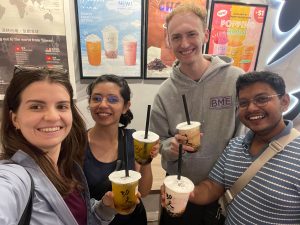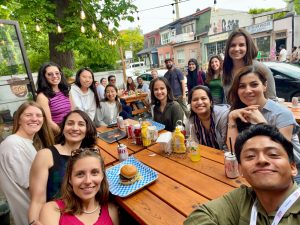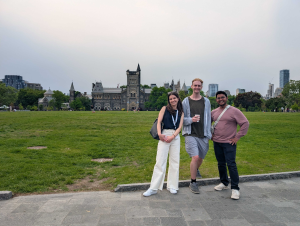Sylvia Almeida is a PhD candidate in the Department of Molecular Genetics at the University of Toronto. Her research leverages chemical genomics to uncover novel therapeutic strategies for human disease in collaboration with other Canadian and international academic teams. She is passionate about health equity, science communication, and translating academic research into real-world solutions. Follow her on X at @SylviaMTAlmeida.
The goal of a PhD is to generate new knowledge. After years of hard work, countless hours in the lab, and too many cups of coffee to count, we earn our degrees by making a novel, significant contribution to our field. Less attention is paid to what comes next: After making your breakthrough discovery, what happens with that idea? How do you turn something that exists only at the bench into a therapy that exists in the clinic?
This past June, I had the opportunity to participate in the Summer by Design program held at the University of Toronto (U of T), and hosted by Medicine by Design and CCRM, in collaboration with U of T’s Rotman School of Management and the Stem Cell Network. This program is designed to expose graduate and postdoctoral fellows working in the field of regenerative medicine to the commercialization process, helping us understand how to translate early-stage discoveries into real-world therapies.
Participants flew to Toronto from across Canada and all over the world to take part in eight full days of programming, including sessions led by industry professionals working across the commercialization landscape. We were introduced to topics such as preclinical de-risking, venture capital, manufacturing, regulatory affairs, and intellectual property. The schedule also included a career panel with industry leaders, discussions with entrepreneurs from the Toronto biotech ecosystem, and workshops with professional coaches to help us refine our communication skills in preparation for a scientific pitch competition held on the final day of the program.
Taking a therapeutic into the clinic is a long and complex process, one which is often underestimated in academic spaces. The Summer by Design program helps bridge this gap by connecting PhD and postdoctoral fellows with professionals involved in various aspects of commercialization, allowing us insight into the challenges and problem-solving required at each stage of the journey.
Toronto as a hub of life science innovation
One of my favorite parts of the program was hearing from founders of regenerative medicine startups based in Toronto. Prior to Summer by Design, I had not fully appreciated how Toronto’s blend of academic, clinical, and industry institutions allows translational research to thrive. As someone who is pursuing a PhD at U of T and is curious about the biotech industry, it was exciting to recognize how much entrepreneurial activity is happening all around me.
A chance to take a break from research and focus on professional development
As a final-year PhD candidate, I often find myself wondering, “What comes next?” Like many of my peers, I followed a traditional academic path, going straight from high school to undergraduate studies to graduate school, never working a full-time job outside academia. The wide range of career paths showcased in the program was eye-opening. These careers are not only intellectually rewarding, but also essential to ensuring that scientific discoveries move beyond the lab and ultimately improve patient lives.
As anyone who has done a PhD knows, the work is demanding and can become all-consuming. It is easy to get tunnel vision and lose sight of the bigger picture when you are deep in experiments, committee meetings, and data analysis. A key aspect of Summer by Design is the requirement that participants step away from their day-to-day responsibilities and fully engage with the program. Spending eight days focused solely on professional development gave me much-needed perspective and a renewed sense of possibility for my career after completing my PhD.
If you are wondering whether to hit pause on your research for this program, my advice is to do it! Your experiments will still be there when you get back —and you will return with a clearer idea of where you want to go next.
Beyond the curriculum: Building community with like-minded scientists
By far, the most valuable part of the program was the connections I made with my fellow participants. Not only were they exceptional scientists doing cutting-edge research, but they were also generous, thoughtful people. In our spare time, we explored the city together as part of a friendly Toronto scavenger hunt competition, checking off tasks that ranged from “eat poutine” to “visit the CN Tower.” Many of us were even able to attend a Blue Jays game in box seats that CCRM kindly donated! After a week and a half of engaging discussions, shared meals, and adventures around Toronto, we returned to our respective corners of the globe—but now we are part of an international community of scientists connected by this unforgettable experience.
Key lessons from Summer by Design
I applied to the Summer by Design program to better understand how academic discoveries are translated into real-world therapeutics and the experience far exceeded my expectations. It reshaped how I think about my own research, encouraging me to view its potential clinical applications through a commercial lens: an invaluable perspective for any scientist.
I also came away with several unexpected but equally valuable takeaways. I learned how to communicate my ideas more effectively to diverse audiences; discovered a wide range of exciting careers in the commercialization pipeline; and joined a global network of inspiring scientists I will remain connected with for years to come. If you have entrepreneurial ambitions or want to explore the many paths available to scientists in industry, I highly recommend this program!
Guest
Latest posts by Guest (see all)
- Regenerative immunotherapy: Hope for chronic autoimmune diseases - September 16, 2025
- Canada’s regenerative revolution: Why AI is the catalyst - September 4, 2025
- Summer by Design: A launchpad for future entrepreneurs and industry scientists - August 14, 2025









Comments